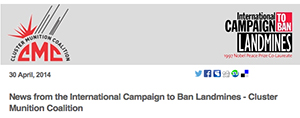24 June 2021
Landmines Continue to Kill and Injure Citizens in Myanmar, in Midst of Humanitarian and Political Crisis
(Geneva, 24 June 2021) - The International Campaign to Ban Landmines (ICBL) is concerned with reports of new antipersonnel mine use and civilian casualties due to landmines and other explosive ordnance in Myanmar. Following the military coup staged on 1 February 2021, violent crackdowns and fighting between the Ethnic Armed Groups, People’s Defense Forces, newly formed non-State armed groups and the Myanmar military continues with no end in sight. A trend of increasing mine casualties had already been reported in recent years, according to the Landmine Monitor.[1] In a context where landmines continue to be planted as a method of warfare, obstructing the movement of civilians and provision of humanitarian aid, it is key for Myanmar to accede to the Mine Ban Treaty and to recognize that humanitarian mine action is a prerequisite to any immediate or long-term recovery.
Civilians pay a heavy human cost for the State’s failure to clear landmines and other explosive ordnance from contaminated areas. UNICEF[2] has reported a total of 72 incidents across Myanmar in the first four months of 2021, with a spike of incidents in March and a total of 25 people dead and 47 injured. The impact of incidents is more concerning on men and boys. 28 children have already been killed or injured in 2021. The survivors of landmines and other explosive ordnance may experience lifelong impairments,[3] psychological trauma, social exclusion and educational hurdles. Persons injured do not have appropriate access to emergency healthcare and rehabilitation services due to the collapse of the healthcare system since the coup.
There have been reports about the new use of landmines by both the Myanmar military forces and ethnic armed groups.[4] In areas of intense clashes between armed groups and the military since the coup, such as Mindat, Chin State and Kayah State,[5] reports of the military forces planting landmines surfaced among local groups.[6] The UN Special Rapporteur for Myanmar Tom Andrews shared on 8 June: “I have received distressing reports that junta forces are laying landmines on public roads” in Kayah State.[7] Rakhine state continues to be an area with a higher rate of casualties, 43%, than other parts of the country.[8]
Across Myanmar, clashes between armed groups continue and fighting, conflict, political instability, and the deterioration of living conditions have driven people away from their homes. In early June, the UNHCR estimated a total of 175,000 people displaced within Myanmar since 1 February 2021.[9] A few days later, the UN reported about 100,000 people being forced to flee in Kayah.[10] Landmines and the continued absence of an effective clearance program continue to be a major barrier for displaced persons to flee as well as secure a dignified and safe return to their villages. Internally displaced persons have reported that they fear returning to their villages because of the presence of landmines.[11]
The use of landmines in the country has been documented every year by Landmine Monitor since it began documentation in 1999. The full extent of contamination in Myanmar is unknown, but contamination from both improvised landmines and mines produced in state-owned factories has been recorded by Landmine Monitor in 90 townships and 10 states and regions.[12]
ICBL calls upon all armed actors in Myanmar to immediately halt use of landmines. ICBL also calls on all authorities to start immediate actions to clear landmines and other explosive ordnance from contaminated areas in accordance with international standards and to stop impeding critical humanitarian aid. Humanitarian mine action operators should be able to implement their programming without impediments, including risk education, victim assistance, technical and non-technical surveys, clearance of mines and explosive remnants of war, and advocacy.
ICBL also urges Myanmar to accede to the Convention on the Prohibition of the Use, Stockpiling, Production and Transfer of Anti-Personnel Mines and on Their Destruction.
[2] UNICEF, 2 June 2021, Myanmar Landmine/ERW Incidents Information https://www.unicef.org/myanmar/reports/myanmar-landmineerw-incidents-information-4
[3] UN Security Council, Report of the Secretary-General, Protection of civilians in armed conflict, 3 May 2021, S/2021/423,https://www.securitycouncilreport.org/un_documents_type/secretary-generals-reports/?ctype=Protection%20of%20Civilians&cbtype=protection-of-civilians; and
https://reliefweb.int/report/myanmar/myanmar-humanitarian-update-no-7-27-may-2021
[4] Burma mine ban, 7 June 2021, End the suffering caused by antipersonnel mines, https://burmamineban.demilitarization.net/?p=1078
[5] UN Special Rapporteur, 8 June 2021, UN Special Rapporteur Calls for Immediate Action to Avoid Massive Loss of Life in Kayah State, Myanmar, https://twitter.com/rapporteurun/status/1402395474120806409
[6] Chinland World Media, 12 May 2021, https://twitter.com/media_chin/status/1392456235232808961
[7] Al-Jazeera, 9 June 2021, UN warns of ‘mass deaths’ in Myanmar after 100,000 flee fighting, https://www.aljazeera.com/news/2021/6/9/un-warns-of-mass-deaths-in-myanmar-after-100000-flee-fighting
[8] UNICEF, 2 June 2021, Myanmar Landmine/ERW Incidents Information https://www.unicef.org/myanmar/reports/myanmar-landmineerw-incidents-information-4
[9] UNHCR Regional Bureau for Asia and Pacific (RBAP) Myanmar Emergency - External Update, 1 June 2021, https://reliefweb.int/report/myanmar/unhcr-regional-bureau-asia-and-pacific-rbap-myanmar-emergency-external-update-1-june
[10] UN News, 9 June 2021, ‘Mass deaths’ alert in Myanmar as 100,000 flee junta’s heavy weapons, https://news.un.org/en/story/2021/06/1093652
[11] Para 44, of the Report of the Special Rapporteur on the situation of human rights in Myanmar, Thomas H. Andrews, Human Rights Council Forty-sixth session 22 February–19 March 2021 A/HRC/46/56


